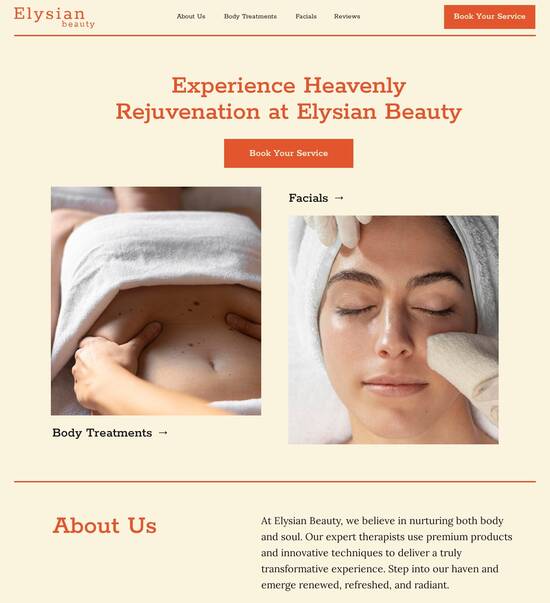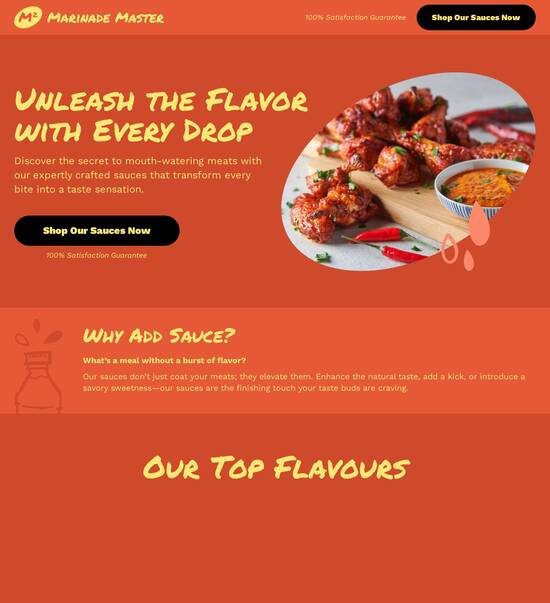
HTML page template with interactive employee engagement survey
Explore Similar TemplatesAbout template
Use HTML page templates with interactive employee engagement survey and make your communications easy and transparent. Try our solution today.
Recommended templates

Easy to build without coding
With the intuitive drag-and-drop builder, anyone on your team can create high-converting pages without any knowledge of code or design. Make enhancements to your landing page with custom widgets using Javascript, HTML/CSS, or third-party scripts.

Multiple layouts for any industry and goal
Select from 500+ landing page layouts built to boost conversions across industry-specific scenarios. Customize them by adjusting fonts, adding images, and generating on-brand content with the AI assistant. Quickly scale with Instablocks® and Global Blocks that you can save, reuse, and update globally.

Loads fast and looks polished on any device
Every template is responsive, which means they present professionally on any device and load blazingly fast with our Thor Render Engine. You can also power them up with Google AMP technology to deliver an unparalleled mobile experience and drive higher conversions.

Robust analytics & experimentation
Get real-time updates and reporting across all your devices, showing the number of visitors, conversions, cost-per-visitor, and cost-per-lead. Launch AI-powered experiments, run A/B tests, and use heatmaps to analyze user behavior, then optimize your landing page to maximize conversions.







Easy to build without coding
With the intuitive drag-and-drop builder, anyone on your team can create high-converting pages without any knowledge of code or design. Make enhancements to your landing page with custom widgets using Javascript, HTML/CSS, or third-party scripts.
Multiple layouts for any industry and goal
Select from 500+ landing page layouts built to boost conversions across industry-specific scenarios. Customize them by adjusting fonts, adding images, and generating on-brand content with the AI assistant. Quickly scale with Instablocks® and Global Blocks that you can save, reuse, and update globally.
Loads fast and looks polished on any device
Every template is responsive, which means they present professionally on any device and load blazingly fast with our Thor Render Engine.
Robust analytics & experimentation
Get real-time updates and reporting across all your devices, showing the number of visitors, conversions, cost-per-visitor, and cost-per-lead. Launch AI-powered experiments, run A/B tests, and use heatmaps to analyze user behavior, then optimize your landing page to maximize conversions.
All the features you need to build lead-generating landing pages
Explore more featuresLearn how to build top-performing landing pages for any goal
FAQs
Leading the way in building high-performing landing pages





A step-by-step guide to creating effective landing pages with Instapage
Creating effective landing pages is crucial for marketers aiming to optimize conversion rates and maximize ROI. Instapage is the most powerful landing page and conversion rate optimization (CRO) platform that empowers marketers with tools to enhance their digital campaigns efficiently. This guide will walk you through the essential steps to utilize Instapage effectively.
Understanding the importance of landing pages
Landing pages serve as focused destinations that drive user actions, whether it’s signing up for a newsletter or making a purchase. They eliminate distractions and funnel visitors towards specific goals, significantly increasing conversion rates. By using specialized templates and strategically designed elements, your landing pages can capture leads and drive results.
- Higher conversions: By providing targeted content, landing pages can effectively convert visitors into leads or customers.
- Improved user experience: A streamlined design specifically for campaigns enhances the user journey.
- Focused marketing efforts: Landing pages center on specific campaigns, increasing the effectiveness of your marketing strategies.
Step 1: Choose the right template
Instapage offers over 100 high-converting templates and pre-built elements that simplify the page creation process. Here's how to select the best one:
- Consider your campaign goal: Identify whether you want to capture leads, promote products, or encourage sign-ups to select a relevant template.
- Target your audience: Choose templates that resonate with your specific marketing vertical, whether it be education, financial services, or tech.
- Utilize lead generation elements: Incorporate forms and calls-to-action effectively within the template to drive user engagement.
Step 2: Customize your landing page
Tailor your chosen template to fit your campaign’s branding and messaging by following these steps:
- Edit text and imagery: Ensure that copy is clear, concise, and engaging while the images align with your brand identity.
- Incorporate dynamic text replacement: This feature allows you to customize content based on the keyword that brought the visitor to the page, enhancing relevance.
- Test different layouts: Utilize Instablocks to create unique sections within your page, making it easy to change design elements without affecting overall layout.
Step 3: Optimize for conversions
Utilizing Instapage’s built-in optimization features, you can enhance your landing page’s effectiveness through:
- Conducting A/B tests: Experiment with different headlines, visuals, and calls-to-action to identify what resonates best with your audience.
- Implementing heatmaps: Review on-page behavior metrics to understand where visitors are clicking or dropping off.
- Analyzing performance: Use analytics dashboards to gather insights about traffic sources and conversion rates to fine-tune future campaigns.
By following these steps, you can leverage Instapage to create outstanding landing pages that improve conversion rates and maximize your marketing ROI.
Ready to take your digital campaigns to the next level? Start using Instapage today and transform your marketing efforts with powerful landing pages tailored to your audience's needs.
Unveiling the power of HTML page templates: Crafting interactive employee engagement surveys
The significance of employee engagement in today's work environment
Employee engagement is a vital concept that seeks to understand how invested and motivated employees are in their work and the organization’s mission. It is not merely about job satisfaction, but a deeper emotional commitment that influences how employees perform and contribute to their workplace. Engaged employees are more productive, provide better customer service, and are less likely to leave their job. This creates a solid link between engagement levels and overall organizational performance.
Research indicates that organizations with high levels of employee engagement experience significantly better financial performance, enhanced productivity, and lower turnover rates. Statistics show that engaged employees outperform their less engaged peers by up to 147%, showcasing the importance of investing in engagement strategies. With the shift towards remote and hybrid work arrangements, businesses are redefining their employee experience strategies to maintain engagement in diverse environments.
Current trends in employee engagement
With a rapid evolution in work culture, particularly in the wake of global disruptions, employee engagement surveys have also adapted. Current trends indicate a growing focus on mental health and well-being, flexible work arrangements, and meaningful recognition. Statistically, it has been reported that 79% of employees consider a healthy workplace culture as a major factor for staying at a job. This highlights how businesses must remain attuned to changing employee attitudes.
Experience management: Bridging employee insights and business objectives
Experience management refers to the practice of monitoring and improving the various interactions employees have within their organization. Why is it integral to modern business? Experience management focuses on understanding employee sentiments and leveraging this data to drive strategic decisions. With a growing recognition of the value of employee input, experience leaders play a vital role in shaping organizational culture and developing frameworks that encourage employee participation.
The interplay between employee experiences and customer outcomes cannot be overstated. Engaged employees are likely to provide superior service, leading to higher customer satisfaction and retention rates. Numerous case studies illustrate the correlation between employee engagement initiatives and breakthrough business results, confirming that invested employees translate into satisfied customers who advocate for the brand.
Designing the interactive survey: Features of the HTML page template
Creating an interactive employee engagement survey necessitates a well-structured HTML page template. A good template is not merely functional but also visually appealing, making it user-friendly. Key components include intuitive navigation, clear buttons for submission, and an engaging layout that encourages participation. An appealing design can greatly enhance the user experience.
Moreover, the functional elements of the template should promote engagement. Dynamic visuals, such as progress bars, can show how far a participant is in their survey journey, motivating them to complete it. Clearly defined sections prevent overwhelm, and the inclusion of interactive elements like sliders and toggles aids in making the survey enjoyable.
Intuitive Navigation
Visually Appealing Design
Engaging Functional Elements
Dynamic Visual Aids
Customization options further enhance the impact of these surveys. Organizations can tailor surveys to align with their brand identity and cultural values. Incorporating specific questions related to the company’s goals not only yields more pertinent insights but also conveys to employees that their input matters, ultimately fostering a spirit of engagement.
Enhancing user engagement: Interactive features of the survey
To attract maximum participation, interactive questioning techniques are essential. Categorical questions, like multiple-choice and Likert scales, not only simplify the response process but also facilitate data collection. Moreover, including open-ended questions allows employees to express their thoughts freely, offering organizations richer insights into employee sentiment.
Branch logic is another excellent feature that can personalize user experiences. Instead of presenting a standard set of questions to every participant, you can adapt the survey flow based on previous answers, ensuring higher relevancy and engagement. This tailored approach increases the likelihood of employees completing the survey, revealing more comprehensive insights into employee attitudes.
Including a real-time feedback mechanism can significantly enhance engagement. By providing immediate acknowledgment of submitted responses and showing participants where their opinions fit
Personalized Questioning Using Branch Logic
Immediate Feedback on Submissions
Variety of Question Types for Engagement
Communicating outcomes instantly utilizing visual representations can keep participants informed about the overall results of the survey, creating a sense of collective effort and community. This prompts employees to view their contributions as valuable, which can impair overall engagement positively.
Gathering insights: Analyzing employee attitudes effectively
To make data-driven decisions, organizations need effective methods to collect and interpret survey findings. This means establishing key performance indicators (KPIs) to assess engagement levels accurately. Use of metrics such as response rates, average scores on key questions, and trend analysis over time can reveal underlying patterns and inform action steps.
Once data is collected, turning insights into actionable strategies is crucial. By proposing initiatives that align with employee feedback, organizations can directly address concerns and foster a culture that values contribution. Engaging in follow-up discussions regarding survey outcomes can further build trust, showing employees that their voices are heard.
Establish Key Performance Indicators
Use Metrics to Identify Trends
Propose Initiatives Based on Feedback
Visualization tools can greatly enhance reporting processes. By translating survey data into comprehensive dashboards, stakeholders can easily grasp insights at a glance. Technologies such as Tableau and Google Data Studio can assist in showcasing employee engagement levels with vivid, easily interpretable graphics.
Use cases: Transforming employee engagement strategies across various sectors
Different sectors have unique challenges and opportunities when it comes to employee engagement. For instance, in the technology industry, companies have successfully used engagement surveys to foster innovation and adaptability. Organizations such as Google and Apple utilize employee feedback to enhance team dynamics and facilitate creative processes, utilizing interactive surveys to maintain their competitive edge.
In hospitality, engaging employees means better service delivery. Leading hotel chains like Marriott conduct regular engagement surveys to measure employee sentiment and service effectiveness, subsequently aligning training and development programs based on collected insights. They’ve proven that higher engagement rates lead to exceptional customer experiences and loyalty.
Tech Industry: Foster innovation through feedback
Hospitality: Enhance service delivery with engagement insights
Healthcare: Improve team morale and patient care through regular feedback
Even organizations in the healthcare sector are leveraging engagement strategies. By conducting thorough surveys, hospitals can address employee burnout and ensure that staff are motivated to provide critical healthcare services, thereby enhancing patient care.
The broader impact: Employee engagement on company culture and performance
Regular engagement surveys can play a significant role in stimulating positive cultural changes within the organization. They foster a feedback-rich environment where employees feel valued and included, leading to improved morale. When employees witness that their feedback drives significant company decisions, their sense of belonging strengthens, promoting loyalty.
Forecasting the future of employee engagement indicates an ongoing shift towards personalization and employee well-being. Businesses need to be prepared to adapt to the evolving expectations of their workforce. By focusing on continuous feedback and improvement, organizations can align their strategies with employee aspirations, leading to enhanced engagement and performance.
Foster a Culture of Continuous Feedback
Prioritize Employee Well-being and Personalization
Conclusion on employee engagement surveys: A strategic imperative
In summary, interactive employee engagement surveys powered by HTML page templates represent a strategic imperative for organizations aiming to thrive in a competitive market. These surveys not only provide crucial insights into employee sentiments but also help foster a culture of openness and involvement, ultimately driving business success. By effectively collecting and analyzing data, organizations can position themselves for exceptional growth.
The potential of employing innovative engagement strategies through well-designed survey templates can result in transformative impacts for businesses. By championing the voice of employees, companies can build trust, increase loyalty, and achieve remarkable business outcomes across all verticals.
Appendix: Additional insights for experience leaders
For experience leaders looking to implement effective employee engagement surveys, there are various toolkits and platforms available. These tools not only facilitate survey creation and distribution but also integrate data analysis functionalities to help interpret results efficiently. Some popular platforms include SurveyMonkey, Typeform, and Google Forms, each offering unique features that suit different organizational needs.
Additionally, having a resource hub for ongoing engagement strategies can be beneficial. Curated material encompassing articles, webinars, and case studies allows experience leaders to stay updated on best practices and emerging trends. Creating an environment where continuous learning is encouraged will ultimately result in sustained employee engagement and satisfaction.
Recommended survey platforms: SurveyMonkey and Typeform
Resource Hub for ongoing engagement best practices
Ready to skyrocket conversions?
Supercharge your ad campaigns with high-performing landing pages
Get started














